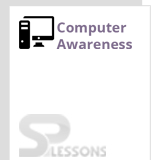 Introduction
Introduction
Basics of Computers and Applications is an important topic in Computer Fundamental. Basics of Computers and Applications Practice Quiz article, is exceedingly important for candidates preparing for RRB ALP/Technical Exams/Junior Engineer Recruitment, SSC CGL, UPSC (Civil services exam including IAS) Exams and etc. In this article, candidates can find different types of questions with solution related to the Basics of Computers and Applications topic. The article Basics of Computers and Applications Practice Quiz, will assist the students understanding of the type of questions expected from the topic Basics of Computers and Applications.
 Quiz
Quiz
1. Which of the following is the fastest ?
- A. CPU
B. magnetic tapes and disks
C. video terminal
D. sensors, mechanical controllers
- A. feeds data to the CPU or memory
B. retrieves data from CPU
C. directs all other units
D. all of these
- A. a device which is not connected to CPU
B. a device which is connected to CPU
C. a direct access storage device
D. an I/O device
- A. Stack
B. Scratchpad
C. Address register
D. Status register
- A. main frames
B. super computers
C. high performance machines
D. mini-and micro-computers
- A. Memory Address Register
B. Memory Data Register
C. Instruction Register
D. Program Counter
- A. Memory Address Register
B. Memory Data Register
C. Instruction Register
D. Program counter
- A. shorter than machine cycle time
B. larger than machine cycle time
C. exactly double the machine cycle time
D. exactly the same as the machine cycle time
- A. CPU
B. ALU
C. program
D. registers
- A. accumulator
B. program status word (PSW) only
C. Instruction Address Counter (IAC) only
D. both PWS and IAC
- A. clearing the bus
B. latching information on the bus
C. deciding the controller of the bus
D. controlling the bus
- A. ALU
B. Instruction Register Unit
C. Control Unit
D. Disk Control Interface Unit
- A. inquiry
B. backup
C. update
D. programming
- A. They can be used as turn around documents
B. They are inexpensive
C. Input is slow compared with other media
D. They are easily damaged
- A. input media
B. output media
C. secondary storage media
D. all of these
1. In the context of Information Technology, OCR means
- A. Optical Character Recognition
B. Octagonal Cyclic Recharge
C. Octadecimal Cyclic Regeneration
D. Optical Character Regeneration
- A. 0
B. 1
C. 2
D. -1
- A. Keyboard
B. Joy stick
C. ALU
D. Printer
- A. It is a software subroutine around which other subroutines are built
B. It is a representation of real numbers to facilitate computing
C. It is the main algebraic formula of the software
D. It is the voltage point given to various operating units of the computer
- A. software programme
B. algorithm
C. protocol
D. information processing
- A. Tape calculator
B. Babbage machine
C. Turing machine
D. Theoretical machine
- A. CCS
B. Unicode
C. Standard CCS code
D. Universal CCS code
- A. Coding
B. Malware
C. Virus
D. Encryption
- A. open source software
B. unlicensed software
C. free software
D. community software
- A. C++
B. Java
C. Python
D. None of these
- A. Microsoft windows is GUI
B. Linux is GUI
C. More than 5000 kB data can be stored in a DVD
D. A 1 TB flash drive can store 2 million files each of size 1 MB
- A. computers
B. environmental engineering
C. diesel engine
D. engineering drawing and orthogonal projections
- A. size of memory
B. speed of computation
C. clock speed
D. none of the above
- A. [latex]{2}^{3}[/latex]
B. [latex]{2}^{3} - 1[/latex]
C. 24
D. [latex]{2}^{4} - 1[/latex]
- A. A set of programmes which controls computer working
B. The way a computer operator works
C. Conversion of high level language into machine level language
D. None of these
1. Which of these is NOT an Operating System?
- A. Android
B. ios
C. Linux
D. Power point
- A. Format creator
B. Format fidelity
C. WYSIWYG
D. WYGIWYS
- A. [latex]{U}\leftrightarrow{HL}\leftrightarrow{C}\leftrightarrow{ML}\leftrightarrow{Comp}[/latex]
B. [latex]{U}\leftrightarrow{C}\leftrightarrow{hL}\leftrightarrow{mL}\leftrightarrow{Comp}[/latex]
C. [latex]{U}\leftrightarrow{C}\leftrightarrow{ML}\leftrightarrow{HL}\leftrightarrow{Comp}[/latex]
D. [latex]{U}\leftrightarrow{ML}\leftrightarrow{HL}\leftrightarrow{C}\leftrightarrow{Comp}[/latex]
- A. Joy Stick
B. Mouse
C. Modem
D. Printer
- A. Microsoft
B. Apple INC
C. IBM
D. None of these
- A. Spice routing
B. Onion routing
C. Cabbage routing
D. Flower routing
- A. MIPS(Million Instruction Per Second)
B. MHz of clock
C. Both (a) and (b)
D. None of these
- A. menu bar
B. title bar
C. standard tool bar
D. common tasks toolbar
- A. i = i + 1
B. i = i + 2
C. i = 2i
D. None of these
- A. #
B. = =
C. ! =
D. < =
- A. Word-processing program
B. Database program
C. Operating system
D. Graphics program
- A. Compiler
B. Joy stick
C. Ports
D. Light pen
- A. Auto insert
B. Auto correct
C. Auto summarize
D. Track changes
- A. Hard Disc Drive
B. Random Access Memory (RAM)
C. Read Only Memory (ROM)
D. The storage device where the operating system is stored
- A. Rows
B. Columns
C. Cells
D. All of the above



